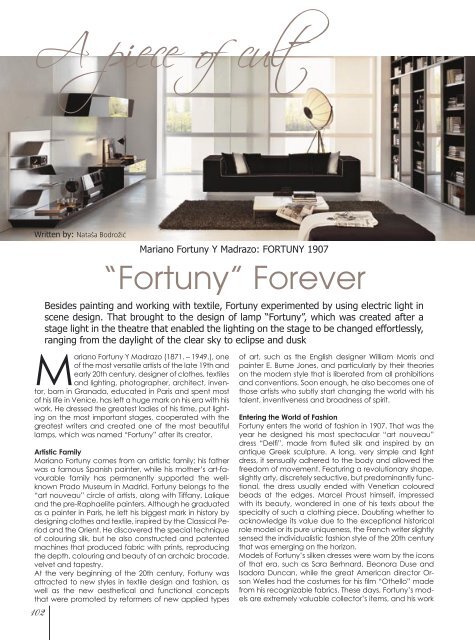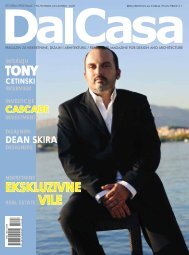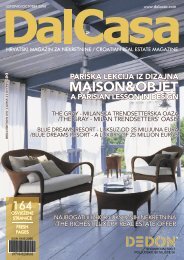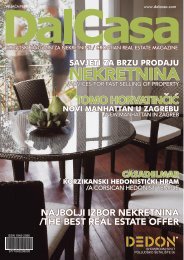100% DESIGN LONDON - DalCasa
100% DESIGN LONDON - DalCasa
100% DESIGN LONDON - DalCasa
You also want an ePaper? Increase the reach of your titles
YUMPU automatically turns print PDFs into web optimized ePapers that Google loves.
A piece of cult<br />
Written by: Nataša Bodrožiæ<br />
Mariano Fortuny Y Madrazo: FORTUNY 1907<br />
“Fortuny” Forever<br />
Besides painting and working with textile, Fortuny experimented by using electric light in<br />
scene design. That brought to the design of lamp “Fortuny”, which was created after a<br />
stage light in the theatre that enabled the lighting on the stage to be changed effortlessly,<br />
ranging from the daylight of the clear sky to eclipse and dusk<br />
Mariano Fortuny Y Madrazo (1871. – 1949.), one<br />
of the most versatile artists of the late 19th and<br />
early 20th century, designer of clothes, textiles<br />
and lighting, photographer, architect, inventor,<br />
born in Granada, educated in Paris and spent most<br />
of his life in Venice, has left a huge mark on his era with his<br />
work. He dressed the greatest ladies of his time, put lighting<br />
on the most important stages, cooperated with the<br />
greatest writers and created one of the most beautiful<br />
lamps, which was named “Fortuny” after its creator.<br />
Artistic Family<br />
Mariano Fortuny comes from an artistic family; his father<br />
was a famous Spanish painter, while his mother’s art-favourable<br />
family has permanently supported the wellknown<br />
Prado Museum in Madrid. Fortuny belongs to the<br />
“art nouveau” circle of artists, along with Tiffany, Lalique<br />
and the pre-Raphaelite painters. Although he graduated<br />
as a painter in Paris, he left his biggest mark in history by<br />
designing clothes and textile, inspired by the Classical Period<br />
and the Orient. He discovered the special technique<br />
of colouring silk, but he also constructed and patented<br />
machines that produced fabric with prints, reproducing<br />
the depth, colouring and beauty of an archaic brocade,<br />
velvet and tapestry.<br />
At the very beginning of the 20th century, Fortuny was<br />
attracted to new styles in textile design and fashion, as<br />
well as the new aesthetical and functional concepts<br />
that were promoted by reformers of new applied types<br />
102<br />
of art, such as the English designer William Morris and<br />
painter E. Burne Jones, and particularly by their theories<br />
on the modern style that is liberated from all prohibitions<br />
and conventions. Soon enough, he also becomes one of<br />
those artists who subtly start changing the world with his<br />
talent, inventiveness and broadness of spirit.<br />
Entering the World of Fashion<br />
Fortuny enters the world of fashion in 1907. That was the<br />
year he designed his most spectacular “art nouveau”<br />
dress “Delfi”, made from fluted silk and inspired by an<br />
antique Greek sculpture. A long, very simple and light<br />
dress, it sensually adhered to the body and allowed the<br />
freedom of movement. Featuring a revolutionary shape,<br />
slightly arty, discretely seductive, but predominantly functional,<br />
the dress usually ended with Venetian coloured<br />
beads at the edges. Marcel Proust himself, impressed<br />
with its beauty, wondered in one of his texts about the<br />
specialty of such a clothing piece. Doubting whether to<br />
acknowledge its value due to the exceptional historical<br />
role model or its pure uniqueness, the French writer slightly<br />
sensed the individualistic fashion style of the 20th century<br />
that was emerging on the horizon.<br />
Models of Fortuny’s silken dresses were worn by the icons<br />
of that era, such as Sara Berhnard, Eleonora Duse and<br />
Isadora Duncan, while the great American director Orson<br />
Welles had the costumes for his film “Othello” made<br />
from his recognizable fabrics. These days, Fortuny’s models<br />
are extremely valuable collector’s items, and his work
















